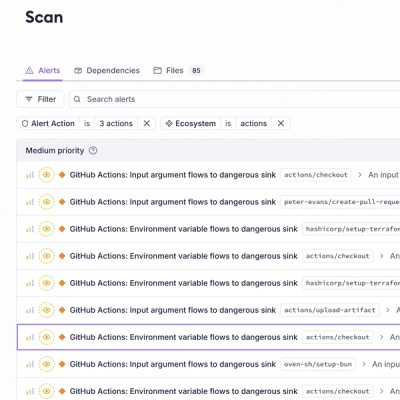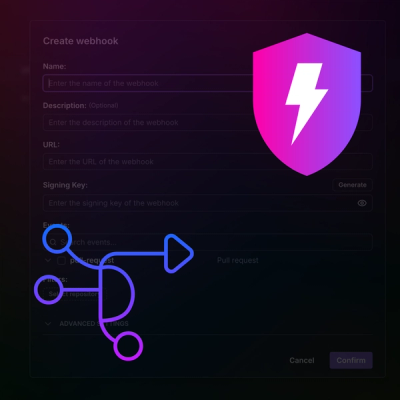
Security News
New CNAPulse Dashboard Tracks CNA Activity and Disclosure Trends
Open source dashboard CNAPulse tracks CVE Numbering Authorities’ publishing activity, highlighting trends and transparency across the CVE ecosystem.
oauthio-web
Advanced tools
This is the JavaScript SDK for OAuth.io. OAuth.io allows you to integrate 100+ providers really easily in your web app, without worrying about each provider's OAuth specific implementation.
To get the SDK, you can :
Zip file
Just copy the dist/oauth.js or dist/oauth.min.js to your project.
Bower
$ bower install oauthio-web
npm for browserify
$ npm install oauthio-web
In the <head> of your HTML, include OAuth.js
<script src="/path/to/oauth.js"></script>
In your Javascript, add this line to initialize OAuth.js
OAuth.initialize('your_app_public_key');
To connect your user using facebook, 2 methods:
//Using popup (option 1)
OAuth.popup('facebook')
.done(function(result) {
//use result.access_token in your API request
//or use result.get|post|put|del|patch|me methods (see below)
})
.fail(function (err) {
//handle error with err
});
//Using redirection (option 2)
OAuth.redirect('facebook', "callback/url");
In callback url :
OAuth.callback('facebook')
.done(function(result) {
//use result.access_token in your API request
//or use result.get|post|put|del|patch|me methods (see below)
})
.fail(function (err) {
//handle error with err
});
You can make requests to the provider's API manually with the access token you got from the popup or callback methods, or use the request methods stored in the result object.
GET Request
To make a GET request, you have to call the result.get method like this :
//Let's say the /me endpoint on the provider API returns a JSON object
//with the field "name" containing the name "John Doe"
OAuth.popup(provider)
.done(function(result) {
result.get('/me')
.done(function (response) {
//this will display "John Doe" in the console
console.log(response.name);
})
.fail(function (err) {
//handle error with err
});
})
.fail(function (err) {
//handle error with err
});
POST Request
To make a POST request, you have to call the result.post method like this :
//Let's say the /message endpoint on the provider waits for
//a POST request containing the fields "user_id" and "content"
//and returns the field "id" containing the id of the sent message
OAuth.popup(provider)
.done(function(result) {
result.post('/message', {
data: {
user_id: 93,
content: 'Hello Mr. 93 !'
}
})
.done(function (response) {
//this will display the id of the message in the console
console.log(response.id);
})
.fail(function (err) {
//handle error with err
});
})
.fail(function (err) {
//handle error with err
});
PUT Request
To make a PUT request, you have to call the result.post method like this :
//Let's say the /profile endpoint on the provider waits for
//a PUT request to update the authenticated user's profile
//containing the field "name" and returns the field "name"
//containing the new name
OAuth.popup(provider)
.done(function(result) {
result.put('/message', {
data: {
name: "John Williams Doe III"
}
})
.done(function (response) {
//this will display the new name in the console
console.log(response.name);
})
.fail(function (err) {
//handle error with err
});
})
.fail(function (err) {
//handle error with err
});
PATCH Request
To make a PATCH request, you have to call the result.patch method like this :
//Let's say the /profile endpoint on the provider waits for
//a PATCH request to update the authenticated user's profile
//containing the field "name" and returns the field "name"
//containing the new name
OAuth.popup(provider)
.done(function(result) {
result.patch('/message', {
data: {
name: "John Williams Doe III"
}
})
.done(function (response) {
//this will display the new name in the console
console.log(response.name);
})
.fail(function (err) {
//handle error with err
});
})
.fail(function (err) {
//handle error with err
});
DELETE Request
To make a DELETE request, you have to call the result.del method like this :
//Let's say the /picture?id=picture_id endpoint on the provider waits for
//a DELETE request to delete a picture with the id "84"
//and returns true or false depending on the user's rights on the picture
OAuth.popup(provider)
.done(function(result) {
result.del('/picture?id=84')
.done(function (response) {
//this will display true if the user was authorized to delete
//the picture
console.log(response);
})
.fail(function (err) {
//handle error with err
});
})
.fail(function (err) {
//handle error with err
});
Me() Request
The me() request is an OAuth.io feature that allows you, when the provider is supported, to retrieve a unified object describing the authenticated user. That can be very useful when you need to login a user via several providers, but don't want to handle a different response each time.
To use the me() feature, do like the following (the example works for Facebook, Github, Twitter and many other providers in this case) :
//provider can be 'facebook', 'twitter', 'github', or any supported
//provider that contain the fields 'firstname' and 'lastname'
//or an equivalent (e.g. "FirstName" or "first-name")
var provider = 'facebook';
OAuth.popup(provider)
.done(function(result) {
result.me()
.done(function (response) {
console.log('Firstname: ', response.firstname);
console.log('Lastname: ', response.lastname);
})
.fail(function (err) {
//handle error with err
});
})
.fail(function (err) {
//handle error with err
});
Filtering the results
You can filter the results of the me() method by passing an array of fields you need :
//...
result.me(['firstname', 'lastname', 'email'/*, ...*/])
//...
You are welcome to fork and make pull requests. We will be happy to review them and include them in the code if they bring nice improvements :)
To test the SDK, you first need to install the npm modules jasmine-node and istanbul (to get the tests coverage) :
$ sudo npm install -g jasmine-node@2.0.0 istanbul
Then you can run the testsuite from the SDK root directory :
$ jasmine-node --verbose tests/unit/spec
Once you've installed istanbul, you can run the following command to get coverage information :
$ npm test
The coverage report is generated in the coverage folder. You can have a nice HTML render of the report in coverage/lcof-report/index.html
This SDK is published under the Apache2 License.
More information in oauth.io documentation
FAQs
OAuth that just works
The npm package oauthio-web receives a total of 333 weekly downloads. As such, oauthio-web popularity was classified as not popular.
We found that oauthio-web demonstrated a not healthy version release cadence and project activity because the last version was released a year ago. It has 1 open source maintainer collaborating on the project.
Did you know?

Socket for GitHub automatically highlights issues in each pull request and monitors the health of all your open source dependencies. Discover the contents of your packages and block harmful activity before you install or update your dependencies.

Security News
Open source dashboard CNAPulse tracks CVE Numbering Authorities’ publishing activity, highlighting trends and transparency across the CVE ecosystem.

Product
Detect malware, unsafe data flows, and license issues in GitHub Actions with Socket’s new workflow scanning support.

Product
Add real-time Socket webhook events to your workflows to automatically receive pull request scan results and security alerts in real time.